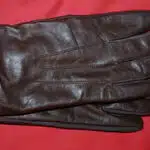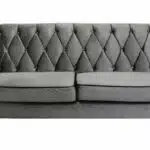Leather sofas are a popular choice of furniture for many homeowners. They are durable, comfortable, and add a touch of sophistication to any living space. However, like any other piece of furniture, leather sofas require regular cleaning and maintenance to ensure their longevity and retain their aesthetic appeal.
As a leather furniture care specialist, I have seen many cases where the lack of proper cleaning has resulted in irreversible damage to leather sofas. Therefore, it is essential for homeowners to understand the proper techniques and products required for cleaning their leather sofas effectively. In this article, I will provide you with step-by-step instructions on how to clean a leather sofa without damaging the material or compromising its quality. By following these guidelines, you can rest assured that your leather sofa will remain in pristine condition for years to come.
Assessing Your Leather Sofa’s Condition
Have you ever owned a leather sofa that has been passed down from generation to generation? It may have some scratches, stains or even cracks due to wear and tear. To ensure your leather sofa lasts for many more years, it is essential to check its durability and seek professional help if necessary.
The first step in assessing the condition of your leather sofa is to inspect its surface. Check for any scratches, cuts, or tears on the surface of the leather. Look closely at the color – has it faded over time? If so, this could be an indication that the leather is damaged and requires attention.
Next, test the durability of your leather sofa by pressing down on different parts of its surface. If you notice any sagging or softness in certain areas, it may be a sign that there is damage beneath the surface that requires immediate attention. Seeking professional help from a leather furniture care specialist can assist you in identifying such issues and provide appropriate solutions.
Remember, taking good care of your leather sofa will not only extend its lifespan but also retain its beauty for years to come. In the next section, we will discuss how to gather cleaning supplies necessary for maintaining your beloved furniture piece effectively.
Gathering Your Cleaning Supplies
- Before beginning any leather furniture cleaning process, it is important to assess the cleaning materials, supplies, and tools that are necessary.
- An appropriate leather cleaner should be chosen based on the type and condition of the leather furniture.
- Additional supplies such as a clean, soft cloth, a vacuum, and a brush may be required to help complete the cleaning process.
- Care should be taken to ensure that all products used in the cleaning process are compatible with the leather furniture.
Gathering Your Cleaning Supplies
As a leather furniture care specialist, I know that cleaning a leather sofa can be a daunting task. However, with the right cleaning supplies and techniques, it can be done effectively without damaging the material. To begin with, gather all the necessary supplies before starting the cleaning process. This includes a soft-bristled brush, microfiber cloths, distilled water, white vinegar, and a leather conditioner.
When choosing cleaning supplies for your leather sofa material, it is important to ensure that they are safe and effective. Avoid using harsh chemicals or abrasive materials that may cause damage to the surface of your sofa. Instead, opt for gentle solutions such as distilled water and white vinegar which are natural and non-toxic.
In addition to these basic supplies, you may also need specialized products depending on the type of stain or dirt you need to remove from your sofa. Always read the labels carefully before using any product on your leather furniture to avoid causing any unwanted damage. By gathering all the necessary cleaning supplies beforehand, you can ensure that you have everything you need to clean your leather sofa safely and effectively.
Choosing The Right Cleaning Solutions
Choosing the Right Cleaning Solutions is an essential aspect of leather furniture care. It is important to remember that not all cleaning solutions are created equal, and some may cause more harm than good. As a leather furniture care specialist, I highly recommend using natural and non-toxic cleaning solutions such as distilled water and white vinegar. These DIY cleaning solutions are gentle on the surface of your sofa and are effective in removing dirt and stains.
When it comes to Leather Conditioner Options, there are many different products available on the market. It is important to choose a conditioner that is specifically designed for use with leather furniture. Avoid using generic or multi-purpose conditioners as they may contain harsh chemicals that can damage the material. Always read the labels carefully before purchasing any product to ensure that it is safe for use on your leather furniture.
In summary, choosing the right cleaning solutions and leather conditioner options is crucial for maintaining the beauty and longevity of your leather sofa. By opting for natural and non-toxic cleaning solutions, you can effectively remove dirt and stains without causing any damage to the surface of your sofa. Additionally, selecting a high-quality leather conditioner will help keep your sofa looking its best for years to come.
Removing Loose Dirt And Debris
Now that you have gathered all the necessary cleaning supplies, it is time to start removing loose dirt and debris from your leather sofa. The first step in this process is to use a lint roller on the entire surface of the sofa. This will help pick up any loose particles that may be stuck to the leather.
Next, pre-clean the sofa with a dry cloth. Gently wipe down the surface of the leather, paying extra attention to any areas that may have accumulated more dirt or debris than others. This will help prepare the surface for further cleaning.
Once you have completed these steps, it’s time to move on to vacuuming the sofa. This will help remove any remaining dirt or debris that has not been picked up by the lint roller or dry cloth. Using a vacuum cleaner with a soft brush attachment, gently go over every inch of the sofa in a back-and-forth motion. Be sure to pay extra attention to areas where dirt and debris tend to accumulate such as creases and seams.
By following these steps, you can ensure that your leather sofa is properly cleaned before moving on to deeper cleaning methods. Remember, taking care of your furniture not only keeps it looking great but can also extend its lifespan for years to come!
Vacuuming The Sofa
- Properly preparing the vacuum is essential in order to effectively clean a leather sofa.
- Before vacuuming, it is important to remove any larger pieces of debris using a lint roller.
- When vacuuming, it is important to use a low-power setting and gently go over the surface of the sofa.
- Care should be taken to ensure that any vacuum attachments used are clean and free of dirt and dust.
- To clean vacuum attachments, they should be wiped down with a damp cloth and dried thoroughly.
- When finished vacuuming, the area should be inspected for any remaining dirt or debris and cleaned as necessary.
Preparing The Vacuum
As a leather furniture care specialist, I understand the importance of maintaining your leather sofa. One crucial step in keeping your leather sofa clean is vacuuming it regularly. However, before you start vacuuming, you need to prepare the vacuum properly.
Choosing the right vacuum for cleaning your leather sofa is essential. You should always use a vacuum cleaner that has an upholstery attachment and soft bristles. Avoid using a stiff brush as it can scratch and damage the leather surface. Additionally, make sure that the vacuum’s suction setting is not too strong, or else it can pull out fibers from the surface of your sofa.
Another essential tip for maintaining your vacuum is to keep it clean and free from debris. Check the dustbin or bag regularly and empty it when it is full. Also, ensure that the filters are cleaned or replaced periodically to maintain optimal suction power. By following these simple tips, you can ensure that your vacuum cleaner is in good working condition and ready to clean your leather sofa effectively.
In conclusion, preparing your vacuum cleaner correctly before starting to clean your leather sofa can make all the difference in achieving excellent results. By choosing a suitable attachment and adjusting its suction power correctly and maintaining it well, you can protect your investment and keep it looking new for years to come!
Vacuuming The Sofa
As a leather furniture care specialist, I cannot stress enough the importance of vacuuming your leather sofa regularly. Vacuuming removes dirt, dust, and debris that can lead to wear and tear on your sofa’s surface. However, it is crucial to use the right technique when vacuuming your leather sofa to avoid damaging it.
When vacuuming your leather sofa, always start by using an upholstery attachment with soft bristles. Avoid using a stiff brush or any attachments that may scratch the surface of your sofa. Additionally, adjust the suction power to avoid pulling out fibers from your sofa. Remember that too much suction can cause more harm than good.
Finally, if you need to clean stains or spills on your leather sofa, use a leather cleaner instead of water-based cleaning methods. Water-based cleaners can damage the surface of your sofa and cause cracks and discoloration over time. Always follow manufacturer instructions when using any cleaning products on your leather furniture to avoid any potential damage or harm. By following these tips, you can keep your leather sofa looking great for years to come!
Cleaning Vacuum Attachments
As a leather furniture care specialist, proper cleaning and maintenance techniques are crucial in prolonging the lifespan of your leather sofa. While vacuuming is an essential part of cleaning your leather sofa, it is also important to consider the tools you use. Cleaning vacuum attachments play a significant role in removing dirt and debris from your sofa’s surface without causing any damage.
When it comes to cleaning vacuum attachments, start by checking if they are compatible with leather materials. Some vacuum attachments may contain stiff bristles that can scratch or damage the surface of your leather sofa. Therefore, it is recommended to use soft-bristled upholstery attachments that are gentle on leather surfaces.
In addition to using the right attachment, it is also important to maintain its cleanliness regularly. Cleaning the vacuum attachments helps remove dust and dirt that may accumulate over time. This can help prevent the transfer of dirt onto your sofa during future cleanings. Properly maintaining your cleaning vacuum attachments not only ensures safe cleaning practices but also promotes a healthier environment for everyone around you.
Treating Stains And Spills
To maintain the appearance and longevity of your leather sofa, it is crucial to treat any spills or stains immediately. Failure to do so can result in irreparable damage that could ruin the aesthetics of your furniture piece. When removing stains from a leather sofa, it is essential to identify the source of the spill and treat accordingly.
For instance, if you notice grease stains on your leather sofa, do not attempt to remove them with soap and water as this may end up spreading the stain further. Instead, sprinkle baking soda or cornstarch over the stain and let it sit for a few hours before wiping it off. For ink or pen stains, use rubbing alcohol on a cotton ball and gently dab at the affected area until the stain disappears.
Preventing future spills is equally important when maintaining a leather sofa. One way to minimize spills is by avoiding eating or drinking while sitting on your sofa. If you must eat while seated on your leather couch, use a tray or placemat to catch any crumbs or spills that may occur accidentally. In addition, place coasters under drinks to prevent condensation rings from forming.
To ensure that your leather sofa remains in pristine condition for years to come, take preventive measures such as covering it when not in use and keeping pets away from it. By following these tips and treating spills immediately when they occur, you can extend the lifespan of your leather furniture piece.
Transition: Now that we have discussed how to remove stains and prevent future spills from damaging your leather sofa, let us move on to choosing the right cleaning solution for general maintenance purposes.
Choosing The Right Cleaning Solution
Choosing the right product is crucial when it comes to cleaning a leather sofa. It is essential to choose a cleaner that is specifically designed for use on leather furniture. Using the wrong product can cause damage or discoloration, which can be irreversible. When selecting a cleaning solution, always read the label and ensure that it is safe for use on your particular type of leather.
There are many natural cleaning alternatives that you can consider when choosing a cleaning solution for your leather sofa. Some of these include vinegar and water, lemon juice and cream of tartar, or even baking soda paste. These natural solutions are great for removing stains and odors without causing any harm to the leather. However, before using any of these alternatives, it is important to test them on an inconspicuous area first.
When selecting a cleaning solution for your leather sofa, it is important to remember that not all products are created equal. Always choose a product that is specifically designed for use on leather furniture and follow the manufacturer’s instructions carefully. If you’re unsure about which product to use, consult with a professional who specializes in leather care. Remember to test the solution on a small area first before applying it to the entire sofa. This will help you avoid any potential damage or discoloration to your valuable piece of furniture.
Testing The Solution On A Small Area
As they say, “measure twice, cut once.” Similarly, before applying any cleaning solution to your leather sofa, it’s recommended that you test its effectiveness on a small area first. This is crucial because it ensures that the solution doesn’t damage or discolor your furniture.
To test the effectiveness of the cleaning solution, select a small and inconspicuous area of your leather sofa. Apply a small amount of the solution using a soft cloth and wait for five minutes. Then, gently wipe off the excess with a clean cloth. Observe if there are any changes in color or texture of the leather. If there are no visible changes, proceed with cleaning the rest of your sofa.
While testing the cleaning solution on a small area is essential, there are a few precautions you need to take as well. Avoid using harsh chemicals or abrasive materials that can scratch or damage your leather furniture. Also, don’t apply too much pressure while wiping off the excess solution as this can cause discoloration or fading of the leather.
Moving forward, you can now confidently proceed to apply the cleaning solution to your entire leather sofa knowing that it won’t cause any harm to your furniture. But before doing so, make sure you have all necessary tools and equipment ready for cleaning your sofa thoroughly.
Applying The Cleaning Solution
Now that you have identified the cleaning solution suitable for your leather sofa, it is time to apply the solution. Before applying, ensure that the solution is adequately mixed and shaken to achieve a uniform mixture. You can use a spray bottle or a clean cloth to apply the solution. Applying techniques differ depending on the type of leather and its condition.
If your sofa has aniline leather, avoid using too much water as it may damage the material. Instead, use a damp cloth to wipe off any dirt or stains gently. On the other hand, if your sofa is made of pigmented leather, you can use a slightly wet cloth to clean it thoroughly. In both cases, do not saturate the sofa with water or cleaning solution as it may lead to discoloration and irreparable damages.
Alternative solutions exist for those who prefer natural remedies. For instance, you can mix vinegar and linseed oil in equal proportions and use this mixture instead of commercial cleaners. Vinegar acts as a disinfectant while linseed oil moisturizes and protects the leather from drying out. However, test this mixture on an inconspicuous area before applying it all over the sofa.
As you apply the cleaning solution, ensure that you cover every inch of the surface evenly. Do not forget to reach into crevices and folds where dirt may accumulate unnoticed. After applying, wait for at least ten minutes before proceeding to wipe off excess cleaner using a dry cloth. Once done, let your sofa dry naturally away from direct sunlight or heat sources before moving on to scrubbing it with a soft brush.
Scrubbing The Sofa With A Soft Brush
- When cleaning leather furniture, it is important to select the correct brushing technique for the type of leather you are cleaning.
- Leather furniture is available in a variety of finishes and treatments, so it is important to understand the type of leather when selecting cleaning products.
- Always use a soft brush with natural bristles to clean the leather, as other types of brushes can be too abrasive and cause damage to the leather.
- Detergents should be avoided for cleaning leather unless specifically designed for leather care and approved for use by the manufacturer.
- Cleaning products designed for leather furniture should be tested on an inconspicuous area before use to ensure safe cleaning.
- Regular maintenance of leather furniture is important to protect the finish and extend the life of the leather.
Brushing Technique
To properly clean a leather sofa, one must use the right tools and techniques. The brushing technique is an essential step in scrubbing a sofa with a soft brush. Using different types of brushes can affect the cleanliness and longevity of your leather furniture. As a leather furniture care specialist, I would recommend using a soft-bristled brush to avoid scratching or damaging the surface of your leather sofa.
When using a soft-bristled brush, start by removing any dirt or debris from the surface of the sofa. Use short and gentle strokes to avoid gouging or scratching the leather. If you notice any stubborn stains or marks on the sofa, it is best to use a leather cleaner before proceeding with brushing. Always follow manufacturer’s instructions when using a cleaner and test it on an inconspicuous area first.
It is important to note that not all brushes are created equal for cleaning leather sofas. Avoid using abrasive brushes such as those with metal bristles or stiff nylon bristles as they can cause damage to your leather furniture. Remember that proper care and maintenance will prolong the life of your leather sofa, so invest in quality tools and take time in cleaning it regularly.
Leather Types
As a leather furniture care specialist, it is important to differentiate between genuine and faux leather when discussing the best cleaning methods for delicate leather types. Genuine leather is a natural product that requires special care to maintain its beauty and durability. On the other hand, faux or synthetic leather is made from plastic-based materials that are easier to clean than genuine leather. It is crucial to know which type of leather you have before proceeding with any cleaning method.
When it comes to scrubbing the sofa with a soft brush, it is crucial to consider the type of leather your sofa is made of. Delicate leathers such as aniline or semi-aniline require gentle cleaning techniques as they are prone to scratches and stains. For these types of leathers, a soft-bristled brush should be used with caution as even small scratches can cause irreparable damage. In contrast, more durable leathers such as pigmented or corrected grain can withstand more vigorous brushing.
In conclusion, knowing the type of leather your sofa is made of is essential in determining the best cleaning methods for delicate leather types. Always use caution when using a soft-bristled brush on aniline or semi-aniline leathers, and opt for more aggressive brushing techniques on more durable leathers such as pigmented or corrected grain. Proper care and maintenance will help prolong the life of your precious leather furniture investment.
Detergents
After establishing the type of leather that a sofa is made of, the next step is to consider the type of detergent to use for cleaning. There are different types of detergents available in the market, each with its advantages and disadvantages. It is imperative to choose the right type of detergent to avoid causing damage to delicate leathers.
There are two main types of detergents used in cleaning leather furniture: water-based and solvent-based detergents. Water-based detergents are mild and gentle on delicate leathers such as aniline or semi-aniline. They contain mild chemicals that dissolve dirt and grime with minimal effort. However, they may not be effective in removing stubborn stains or long-standing dirt.
On the other hand, solvent-based detergents are more potent than water-based detergents since they contain stronger chemicals that can remove stubborn dirt and stains from all types of leather. However, they can be harsh on delicate leathers since they dissolve oils, which can cause cracking or discoloration over time. In conclusion, it is crucial to choose a detergent that suits your leather’s specific needs based on its durability and sensitivity.
Wiping Off The Cleaning Solution
Like a surgeon wiping their instruments before surgery, wiping off the cleaning solution is a crucial step in maintaining the longevity of your leather sofa. Using microfiber cloths to gently remove any excess solution from the surface ensures that no harsh chemicals are left behind that could cause damage to the leather. Think of it as polishing a diamond, every wipe brings out its natural shine.
It is important to note that avoiding harsh chemicals during this process is essential. These chemicals can cause lasting damage to the leather and strip it of its natural oils, causing it to crack over time. Only use products that are specifically designed for leather furniture care and follow the instructions carefully. Leather care specialists recommend using natural cleaning solutions such as white vinegar mixed with water or mild soap.
By following these simple steps, you can ensure that your leather sofa will remain in pristine condition for years to come. The key is consistency and gentle care. Remember, treat your leather sofa like you would treat yourself – with care and attention to detail. Now that we have wiped off the cleaning solution, let’s move on to drying the sofa with a clean cloth.
Drying The Sofa With A Clean Cloth
- Before beginning the process of cleaning a leather sofa, it is important to dampen a clean cloth with lukewarm water.
- Once the cloth has been dampened, it is necessary to wring out any excess water to ensure the leather material is not damaged.
- The cloth should then be gently wiped across the surface of the sofa in a circular motion, taking care to avoid any harsh scrubbing.
- The cloth should be changed often to ensure dirt and grime is not transferred or rubbed into the material.
- After the entire sofa has been wiped down, any remaining moisture should be blotted with a dry cloth.
- Finally, the leather should be left to air dry, or a fan can be used to speed up the drying process.
Dampen The Cloth
As a leather furniture care specialist, I understand the importance of keeping your leather sofa clean and well-maintained. When it comes to drying the sofa with a clean cloth, one key step is to dampen the cloth. This not only helps to remove any remaining dirt or grime on the surface, but also has several other benefits.
Firstly, dampening the cloth helps to prevent scratches or damage to the leather. Dry cloths can be abrasive and rough on the surface, which can lead to scratches over time. Dampening the cloth provides a gentle touch while still being effective in removing any remaining debris.
Secondly, dampening the cloth allows for better absorption of any cleaning solutions that may have been used prior. This ensures that all residue is removed from the surface and prevents any potential damage from harsh chemicals.
While there are alternatives to dampening such as using a dry microfiber cloth or vacuuming, dampening remains one of the most effective methods for cleaning a leather sofa. Taking this extra step ensures that your sofa remains in top condition for years to come.
Wring Out Excess Water
As a leather furniture care specialist, it is important to discuss the proper technique for drying a leather sofa with a clean cloth. After dampening the cloth, the next step is to wring out excess water before using it on the surface. This may seem like an obvious step, but it is often overlooked and can lead to potential damage if not executed properly.
Using a leather conditioner is essential for maintaining the quality of your sofa’s material. However, if excess water is left on the surface when conditioning, it can lead to water damage and discoloration. Wringing out any excess water ensures that the leather is not oversaturated and prevents any potential harm from occurring.
In addition to preventing water damage, wringing out excess water also allows for better absorption of any conditioning products used. When there is too much moisture on the surface, it creates a barrier that prevents proper absorption of the conditioner. Taking this extra step in the drying process ensures that your leather sofa receives full benefits from any conditioning treatments used.
Gently Wipe The Sofa
To ensure the longevity and quality of your leather sofa, it is crucial to know the proper technique in drying it with a clean cloth. In addition to wringing out excess water, gently wiping the surface is also an important step that should not be overlooked.
Using a gentle cleaner on the surface before wiping it dry can help remove any dirt or grime that may have accumulated. It is important to avoid using harsh chemicals or abrasive materials as they can potentially damage the leather. Instead, opt for a mild cleaner specifically designed for leather furniture.
After gently wiping down the surface, consider polishing it with a leather conditioner. This adds an extra layer of protection and helps maintain its shine and softness. Remember to always follow manufacturer instructions when using any conditioning products on your sofa. Taking these steps ensures that your leather sofa remains in top condition for years to come.
Conditioning The Leather
To maintain the quality of your leather sofa, it is essential to condition it regularly. Leather conditioner benefits are numerous as it helps to preserve the natural oils that keep the leather supple and soft. Conditioning also prevents leather cracking and extends the life of your furniture.
Before conditioning, clean any spills or dirt off the sofa with a damp cloth and let it dry completely. Then, apply a small amount of conditioner on a clean, dry cloth and rub it into the leather in circular motions. Make sure to cover all areas of the sofa evenly, including crevices and folds.
After applying conditioner, leave it for at least 30 minutes before wiping away any excess with a dry cloth. Repeat this process every six to twelve months or whenever you notice signs of dryness or cracking on your leather sofa.
To achieve a polished finish on your leather sofa after conditioning, buff it gently with a soft cloth. This will help to remove any excess conditioner while giving your furniture a shiny look. Remember to avoid using harsh chemicals or abrasive materials during the cleaning process as this can damage the leather surface over time. With proper care and maintenance, your leather sofa will remain in excellent condition for years to come.
Buffing The Sofa For A Polished Finish
After conditioning the leather sofa, it is time to buff it for a polished finish. Polishing techniques are crucial in maintaining shine and extending the life of your leather furniture. The process involves gently rubbing the surface with a soft cloth to remove any lingering conditioner residue and restore its natural luster.
To achieve optimal results, use a microfiber cloth or chamois to buff your leather sofa. These materials are gentle enough not to scratch or damage the surface but effective in removing any dirt or debris that may have accumulated over time. Always make sure to apply just enough pressure during buffing to avoid causing any scratches or abrasions on the surface.
Maintaining shine on your leather sofa requires regular polishing as part of your cleaning routine. A monthly polish will not only keep your furniture looking great but also help preserve its quality for years to come. In addition, avoiding direct sunlight and placing the sofa away from heat sources will prevent fading and cracking, ensuring that it remains in excellent condition even after prolonged use.
As important as cleaning is preventive maintenance tips so as not to require frequent cleaning sessions. Proper care should be taken while using your leather sofa; avoid sitting on it with dirty clothes or shoes, wipe spills immediately, and do not allow pets on it without proper protection such as covers or blankets. By following these simple tips, you can enjoy the beauty and comfort of your leather sofa for many years without worrying about frequent cleaning needs.
Preventive Maintenance Tips
A leather sofa is a symbol of sophistication and luxury. It is an investment that adds value to your home and provides comfort for years to come. However, just like any other investment, it requires proper maintenance to ensure its longevity. Preventive maintenance is key to keeping your leather sofa looking new and protecting it from wear and tear.
One way to prevent damage to your leather sofa is through regular leather conditioning. Leather conditioning helps maintain the natural oils in the leather, preventing it from drying out and cracking over time. This process also enhances its shine and color while providing a protective layer against spills and stains. By conditioning your leather sofa every six months, you can keep it looking new for years.
Preventing discoloration is another essential preventive maintenance tip for your leather sofa. Exposure to direct sunlight or heat can cause the leather to fade or change color over time. To avoid this, keep your sofa away from windows or direct sunlight, use protective window treatments or drapes, and avoid placing it near heating sources such as radiators or fireplaces.
- Always clean up spills promptly using a clean cloth.
- Avoid using harsh chemicals or abrasive materials when cleaning your leather sofa.
- Use a soft-bristled brush or vacuum with an upholstery attachment to remove dust and dirt regularly.
By following these preventive maintenance tips, you can prolong the life of your leather sofa while keeping it looking its best. In the next section, we will discuss common issues related to cleaning a leather sofa and provide solutions for troubleshooting them effectively.
Troubleshooting Common Leather Sofa Cleaning Issues
Preventive maintenance is the key to keeping your leather sofa looking its best for years. One of the most important things you can do is to protect it from direct sunlight and heat sources, as these can cause fading and cracking. You should also avoid placing sharp or abrasive objects on the surface, which can scratch or puncture the leather.
Preventing discoloration is another important aspect of leather sofa care. To avoid this issue, you should regularly clean your sofa using a mild soap and water solution. Be sure to test any cleaning products on an inconspicuous area first, to make sure they won’t damage the leather. You should also consider applying a protective coating or conditioner to help keep the leather soft and supple.
Dealing with stubborn stains can be frustrating, but there are several methods you can use depending on the type of stain. For example, ink stains can often be removed using rubbing alcohol, while grease stains may require a specialized cleaner. If you’re not sure how to remove a particular stain, it’s always best to consult with a professional leather cleaner rather than risking damage to your sofa.
Remember that proper care and maintenance will not only keep your leather sofa looking great but will also extend its lifespan. By following these preventive measures and dealing with any issues as soon as they arise, you’ll be able to enjoy your beautiful furniture for many years to come.
Conclusion
When it comes to cleaning your leather sofa, taking a methodical approach is essential. First, assess the condition of your sofa and gather the necessary supplies. Remove any loose dirt and debris before vacuuming the surface. For stains and spills, use a specialized cleaner or a mixture of water and vinegar. After cleaning, conditioning the leather will help to maintain its softness and prevent cracking. Finally, buffing the surface with a dry cloth provides a polished finish.
However, some may argue that professional cleaning services are better suited for maintaining a leather sofa’s longevity. While this may be true in some cases, regular upkeep can go a long way in preserving your investment. Plus, there’s something satisfying about taking care of your possessions yourself. Remember that prevention is key – avoid exposing your sofa to direct sunlight or heat sources and keep it away from sharp objects or pets that could scratch the surface.
Taking care of your leather sofa not only ensures its beauty but also extends its lifespan. By following these tips and troubleshooting any issues that arise, you can enjoy your furniture for years to come. Don’t let neglect or misinformation damage what you’ve worked hard to acquire – show your leather sofa some TLC today!
Image Credits
- “leather sofa” by Birdies100 (featured)





























